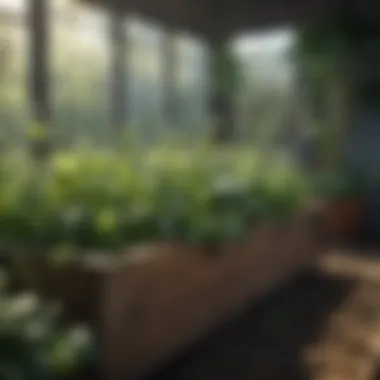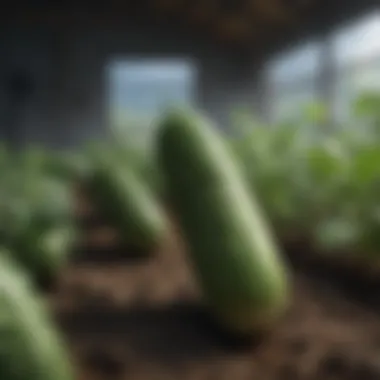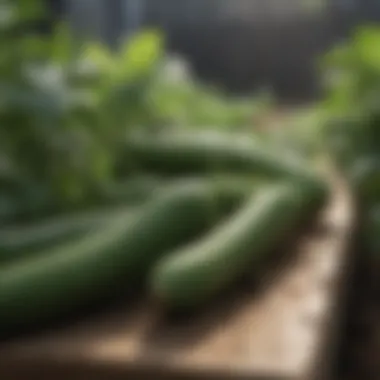Mastering the Art of Cultivating Cucumbers in a Raised Bed for Optimal Growth


Gardening Wisdom
Growing cucumbers in a raised bed offers a myriad of benefits 🥒🌿. The raised bed provides excellent drainage, prevents soil compaction, and allows for better control over soil quality and nutrients. Selecting the right cucumber variety is crucial for a successful harvest. Varieties like slicing cucumbers, pickling cucumbers, or specialty types offer different flavors and textures. Additionally, optimizing soil conditions by ensuring proper p H levels, adequate drainage, and nutrient-rich soil is key to cultivating robust cucumber plants. Implementing organic gardening practices and regularly monitoring plant health are essential for healthy growth and a bountiful harvest.
Introduction to Growing Cucumbers in a Raised Bed
Cultivating cucumbers in a raised bed offers various advantages that can significantly improve the growth and quality of your crops. One of the key benefits is the enhanced drainage system in raised beds, which prevents waterlogging and root rot, promoting healthier plant development. Moreover, the controlled environment of a raised bed allows for better soil quality, ensuring that your cucumbers receive the necessary nutrients for optimal growth. Additionally, raised beds aid in weed control, reducing competition for resources and minimizing the risk of herbicide contamination. Understanding these benefits is essential for successfully nurturing cucumbers in a raised bed.
Benefits of Raised Bed Gardening
Improved Drainage
Improved drainage is crucial in preventing water stagnation, which can lead to various issues such as root rot and fungal diseases. Raised beds, with their elevated structure, facilitate proper water penetration and drainage, ensuring that excess moisture does not accumulate around the cucumber roots. This feature is particularly beneficial during rainy seasons or in areas with heavy rainfall, where waterlogging poses a significant risk to plant health. By promoting adequate drainage, raised beds create a conducive environment for robust cucumber growth and yield.
Better Soil Quality
Better soil quality is another significant advantage of raised bed gardening. The raised structure allows for better control over the soil composition, promoting the use of nutrient-rich soil that is tailored to the specific needs of cucumbers. In raised beds, you can easily amend the soil with organic matter and other beneficial additives to create a fertile growing medium for your plants. This enhanced soil quality translates to healthier plants, improved nutrient uptake, and ultimately, a more abundant cucumber harvest.
Weed Control
Weed control is a common challenge in traditional ground gardening, where weeds can quickly spread and compete with crops for nutrients and sunlight. Raised beds mitigate this issue by providing a contained cultivation area that is less susceptible to weed infestations. The elevated design of raised beds makes it easier to spot and remove weeds, keeping your cucumber plants free from unwanted competition. This proactive approach to weed control contributes to the overall health and productivity of your cucumber crop, ensuring that they thrive without being stifled by invasive plants.


Planting and Caring for Cucumber Plants
When delving into the world of cultivating cucumbers in a raised bed garden, an indispensable aspect is the thorough understanding and application of planting and caring for cucumber plants. This section plays a pivotal role in ensuring the success of your cucumber cultivation endeavor. By focusing on proper planting techniques and diligent care, you set the foundation for healthy growth and abundant harvests. Attention to detail in this phase can significantly impact the overall health and productivity of your cucumber plants. Mastering the art of planting and caring for cucumber plants involves selecting appropriate planting methods, providing necessary nutrients, and monitoring plant health to address any issues promptly.
Planting Cucumber Seeds or Seedlings
Seed Starting Techniques
The process of planting cucumber seeds or seedlings is a crucial step in the journey of cultivating cucumbers in a raised bed setting. One key aspect that demands attention is the selection of the appropriate seed starting techniques. By choosing the right method to initiate the growth of cucumber plants, you set the stage for robust development and optimal yield. Seed starting techniques vary in complexity and resource requirements, offering flexibility based on your gardening expertise and available resources. Understanding the intricacies of each technique allows you to tailor your approach to suit your specific needs and maximize the success of your cucumber planting endeavors.
Transplanting Seedlings
Transplanting seedlings is another critical aspect of planting and caring for cucumber plants in a raised bed environment. This process involves delicately moving young cucumber plants from their initial growing containers to the raised bed, ensuring minimal disturbance to their root systems. Timing and technique play vital roles in the successful transplantation of seedlings, as improper handling can stress the plants and impede their growth. By mastering the art of transplanting seedlings with care and precision, you provide your cucumber plants with the best possible start in their new environment, setting the stage for healthy development and fruitful harvests.
Watering and Fertilizing Guidelines
Optimal Watering Practices
Effective watering practices form the bedrock of successful cucumber cultivation in a raised bed setup. Consistent and adequate moisture levels are essential for the health and vigor of cucumber plants, ensuring optimal growth and fruit production. Optimal watering practices involve understanding the water requirements of cucumbers, adjusting watering frequency based on environmental conditions, and utilizing efficient watering techniques to deliver moisture directly to the plant roots. By mastering the art of optimal watering practices, you provide your cucumber plants with the hydration they need to thrive and flourish in your raised bed garden.
Choosing the Right Fertilizer


Selecting the right fertilizer is a critical decision that impacts the nourishment and development of your cucumber plants in a raised bed environment. The choice of fertilizer depends on various factors such as soil quality, plant nutrient requirements, and growth stage. By identifying the specific needs of your cucumber plants and selecting a suitable fertilizer regimen, you enrich the soil, promote healthy growth, and enhance fruit quality. Understanding the unique characteristics of different fertilizers allows you to make informed decisions that support the vitality and productivity of your cucumber plants, ultimately contributing to a bountiful harvest.
Managing Pests and Diseases
Natural Pest Control Methods
Effective pest management is essential for maintaining the health and resilience of cucumber plants in a raised bed garden. Adopting natural pest control methods offers a sustainable and environmentally friendly approach to safeguarding your plants from harmful insects and pests. These methods encompass a range of techniques such as companion planting, beneficial insect attraction, and cultural practices that disrupt pest lifecycles. By integrating natural pest control methods into your gardening routine, you create a harmonious ecosystem that minimizes pest damage and fosters plant vitality.
Common Diseases to Watch For
Vigilance against common cucumber diseases is paramount in ensuring the long-term success of your raised bed cucumber cultivation. Being aware of prevalent diseases that affect cucumber plants, such as powdery mildew or bacterial wilt, allows you to proactively monitor and address any signs of infestation. Prevention strategies, including proper sanitation practices and crop rotation, can help minimize the risk of disease outbreaks and preserve the health of your cucumber plants. By staying informed about common cucumber diseases and implementing proactive management tactics, you fortify the resilience of your plants and nurture a thriving cucumber garden in your raised bed.
Harvesting and Enjoying Your Cucumber Harvest
In the realm of growing cucumbers in a raised bed, the culminating phase of harvesting and enjoying your labor is a moment of great satisfaction. This section encompasses key insights into judiciously picking ripe cucumbers and exploring creative avenues to relish them. Understanding the nuances of harvesting is crucial to reaping the benefits of your gardening endeavors.
Harvesting Ripe Cucumbers
When it comes to ascertaining the readiness of cucumbers for harvest, there are specific indicators that manifest their ripeness. Discerning these cues is pivotal to ensure the cucumbers are plucked at the optimal time, guaranteeing peak flavor and texture. The concept of recognizing ripeness is fundamental to the overall success of your cultivation journey.
Indications of Ripeness


The significance of identifying ripe cucumbers lies in their tactile and visual characteristics. A ripe cucumber should exhibit vibrant color, firmness to the touch, and a glossy exterior. These qualities not only denote maturity but also enhance the taste profile, making them a preferred choice for consumption. The unique traits of ripe cucumbers contribute significantly to the ultimate goal of savoring fresh produce.
Harvesting Techniques
Delving into the hands-on aspect of gathering ripe cucumbers necessitates finesse and precision. Employing proper harvesting techniques, such as gently twisting the cucumber off the vine or using sharp garden shears, ensures minimal damage to the plant and fruit. The effectiveness of these techniques lies in their ability to preserve the integrity of the cucumbers, translating to an optimal harvest for consumption or storage.
Creative Ways to Enjoy Cucumbers
The realm of cucumber utilization extends beyond mere consumption, offering a plethora of creative avenues to relish this versatile produce. From preparing refreshing salad recipes to exploring pickling ideas, there are ample opportunities to savor cucumbers in innovative ways, amplifying your culinary experiences.
Refreshing Salad Recipes
Integrating cucumbers into salad compositions introduces a refreshing element, elevating the overall flavor profile. Their crisp texture and mild flavor complement a myriad of ingredients, creating a harmonious blend of tastes and textures. Incorporating cucumbers into salads not only enhances nutritional value but also infuses a delightful crunch, making them a popular choice for culinary enthusiasts.
Pickling Ideas
Diving into the art of pickling cucumbers unveils a realm of preservation and flavor enhancement. Pickled cucumbers offer a tangy and flavorful addition to dishes, infusing a burst of acidity and crunch. The distinctive feature of pickling lies in its ability to prolong the shelf life of cucumbers while intensifying their taste. Exploring pickling ideas opens doors to culinary experimentation and preservation techniques, adding depth to your gastronomic pursuits.
Storing Excess Cucumbers
As the abundance of your cucumber harvest unfolds, implementing proper storage methods becomes imperative to maintain their freshness and quality. Whether opting for traditional storage practices or venturing into freezing tips, safeguarding your excess cucumbers ensures extended enjoyment of your yield, minimizing wastage and maximizing utility.
Proper Storage Methods
Effectively storing excess cucumbers involves strategic placement in cool, dark environments, such as refrigerators or root cellars. Adhering to proper storage conditions preserves the cucumbers' texture and taste, prolonging their shelf life and ensuring continued freshness. The advantageous aspect of employing proper storage methods lies in sustaining the cucumbers' integrity, allowing for versatile utilization in various culinary applications.
Freezing Tips
Exploring freezing as a preservation technique for excess cucumbers unveils a convenient and efficient method to extend their utility. Freezing tips encompass preliminary steps such as washing, slicing, and packaging cucumbers in airtight containers, ensuring minimal moisture loss and optimal preservation. The advantageous facet of freezing lies in its ability to retain the cucumbers' quality for future use, enabling seamless integration into dishes even beyond the harvest season.







